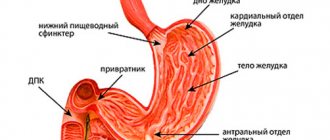Why do you feel sick during pregnancy?
The main reason for nausea is sudden hormonal fluctuations. In a woman’s body, the level of “pregnancy hormones” increases: progesterone and estrogen. Also, soon after conception, human chorionic gonadotropin (hCG) begins to be produced, the levels of which increase every 2-3 days. Nausea and vomiting are a reaction to stress and changes occurring in the body.
Some women experience bouts of nausea and vomiting throughout pregnancy, with little respite in the second trimester. Others have no such symptoms at all. It is impossible to say exactly why this happens. However, there are a number of factors that increase the risk of nausea in pregnant women:
- heredity;
- improper diet before conception and in the first weeks of pregnancy;
- overwork and emotional overload;
- bad habits;
- endocrine disorders.
When does nausea occur during pregnancy?
Nausea most often develops from the early stages of pregnancy, and usually its first manifestations should be expected around the 5-6th week. In women with multiple pregnancies, symptoms may occur 1-2 weeks earlier and last longer.
If the expectant mother has diseases of the digestive system, somatic pathologies, manifestations of toxicosis with nausea will be more pronounced and prolonged.
According to experts, the earlier toxicosis began and the stronger the nausea and vomiting, the longer it will take to manifest itself.
Nausea and vomiting deserve special attention as late-term manifestations of toxicosis. They can last until childbirth and often occur due to increased pressure, swelling and the formation of manifestations, such manifestations are dangerous to health and require immediate medical attention. Often, nausea during gestosis weakens somewhat after the stomach drops by 37-38 weeks or decreases slightly after 35 weeks of pregnancy.
Mostly such manifestations in pregnant women occur during fasting, when the stomach is empty, so it is recommended not to take long breaks in eating.
Features of the course of early toxicosis
The first signs of so-called early toxicosis appear at the 5th obstetric week, when the concentration of hCG reaches high levels (1500-5000 mU/ml). An unpleasant feeling of a lump in the throat most often overcomes a woman in the morning, but can also manifest itself throughout the day. Nausea often ends with vomiting, which does not bring relief. Anything can trigger an attack: perfume, the smell or appearance of food, or household chemicals. If the irritant has been detected, be sure to try to exclude all possible contacts with it.
Nausea is also accompanied by other unpleasant symptoms:
- increased salivation;
- loss of appetite;
- atypical fatigue and drowsiness;
- dizziness and even loss of consciousness;
- weight loss;
- mood swings.
Early toxicosis begins to decline after the 10th week of pregnancy and completely recedes by 12-14 weeks.
In very rare cases, a woman develops uncontrollable vomiting of pregnancy. This syndrome is dangerous due to dehydration and requires treatment in a medical facility.
Features of nausea during early pregnancy
Nausea often accompanies the initial stages of pregnancy, but is not one of its mandatory manifestations. You should not judge only by the presence or absence of morning nausea or vomiting that a baby has appeared in the uterus . Often the first manifestations occur soon after two lines appear on the test, closer to 5-6 weeks,
and are often combined with vomiting, severe salivation and distortion of taste and smell.
note
The appearance of nausea in the first trimester is a completely normal phenomenon; it does not require visiting a doctor, provided that the manifestations do not greatly disrupt the usual life and do not change the usual rhythm. If vomiting is also typical with nausea, repeated and not only in the morning, with toxicosis a woman suddenly loses weight - this is already a reason for examination and treatment.
Important facts about nausea during pregnancy:
Nausea, drooling, appetite
Factors that provoke nausea:
- Most often, nausea occurs in the morning, but in the daytime and evening such sensations are not excluded, although they are not so strong.
- Increased nausea can occur with sudden rises from bed, due to a decrease in pressure, which also threatens dizziness and a feeling of weakness and darkening of the eyes.
- Strong odors or foods (meat, fish, boiled vegetables) can provoke lightheadedness and nausea.
Each expectant mother has her own characteristics during toxicosis; nausea may also occur in the mouth or a feeling of bad odor. Against the background of nausea, you may crave certain foods (sweets, salty foods, chalk, lime). In general, mild toxicosis indicates the progression of pregnancy and the full development of the fetus. But a completely normal phenomenon is also considered to be the almost complete absence of toxicosis or its mild manifestations, which are not permanent and do not interfere with normal life.
If, against the background of toxicosis, you suddenly suddenly feel better, or a pulling sensation appears in the pubic or lower back area, this may indicate a frozen pregnancy. It's better to see a doctor!
Why do you feel sick during late pregnancy?
If early toxicosis is considered to be a “normal” condition in pregnant women, then nausea and vomiting in recent weeks are associated with symptoms of gestosis. It threatens expectant mothers after the 20th week of pregnancy. At risk are women over 35 years of age, as well as pregnant women with a history of pathologies of the excretory and cardiovascular systems. Increases the chances of developing gestosis and multiple pregnancies. In addition to nausea and vomiting, gestosis is characterized by:
- increased blood pressure;
- protein in urine;
- severe swelling of the face and limbs;
- headache;
- blurred vision and the appearance of “spots” before the eyes;
- weakness and inability to do daily activities;
- sudden weight gain not related to diet;
- in rare cases - convulsions and loss of consciousness.
More on the topic
Why do you feel sick during pregnancy?
How to get rid of toxicosis during pregnancy
How to get rid of nausea during pregnancy?
Is it possible to avoid toxicosis during pregnancy?
Early toxicosis during pregnancy: when does it start and how to deal with it?
If nausea in late pregnancy is combined with at least one of these symptoms, consult your doctor immediately. This condition requires immediate hospitalization - the life of the mother and her unborn baby is at risk.
When might signs of toxicosis occur?
Each woman's pregnancy will be different, and it is impossible to say anything specifically, but when asked at what stage of pregnancy you begin to feel sick, the answer is that it will most likely be in the early stages.
Most often, toxicosis occurs in the first trimester of pregnancy and ends, as a rule, after complete hormonal changes in the mother’s body. This can most often happen no earlier than 10-12 days after pregnancy.
But usually this happens only after 3-4 weeks, which is the earliest date. If the symptoms of toxicosis do not disappear or they appear in the late stages of pregnancy, then this can lead to complications for both the mother and the unborn child.
If we take the average indicators, then nausea begins to appear no earlier than after a delay in menstruation, but the most logical and correct reasoning about the time of onset of nausea would be the fact that only in the 4th week of pregnancy do hormones come into play, due to fluctuations in which the appearance of nausea.
As a result, we can say that the most likely time for its appearance will be the fifth or sixth week from fertilization.
But don’t despair if you experience nausea; there are excellent effective ways to treat it.
Is it possible to rid yourself of toxicosis and what to do when you feel sick?
It is almost impossible to get rid of toxicosis. The best advice is to simply endure this difficult period on the path to long-awaited motherhood. But there is good news: nausea and vomiting can be kept under control. It is only important to adhere to the following rules:
- A rational daily routine: enough sleep, walks in the fresh air and moderate physical activity, as approved by your gynecologist. If possible, you should avoid taking public transport and staying in crowded, stuffy rooms.
- Proper nutrition. There is no need to remind you that a pregnant woman’s diet should include only natural and healthy foods. You will have to give up smoked meats, sweets, fried and salty foods. In addition, food should be taken in small portions, but often. This rule also applies to liquids. Some expectant mothers note that during pregnancy they began to eat 4-6 times a day from a small dessert saucer. This helped them reduce the burden on their already irritated gastric tract. And another old but effective method - never get out of bed hungry. In the evening, leave a few saltine crackers, dried fruits and a glass of water on your bedside table.
- Ethnoscience. Many women are helped by natural remedies: a decoction of chamomile, rosehip, infusion of valerian, mint or calendula, as well as warm water with honey, lemon and ginger. However, it is worth remembering that seemingly harmless herbs may turn out to be unsafe during pregnancy and even provoke premature birth. Do not rely on the advice of friends and acquaintances and be sure to consult with the doctor monitoring your pregnancy.
- Taking vitamins. Vitamin complexes for pregnant women are selected by a specialist individually for each pregnant woman. Vitamin B6 is the best way to cope with severe nausea and vomiting.
- The simplest yoga asanas, meditation and breathing practices.
- Aromatherapy. Despite the fact that pregnant women cannot tolerate strong odors very well, citrus and pine aromas can be a real salvation. Spray water with natural oils in the room or turn on an aroma lamp.
Fortunately, not every woman experiences bouts of nausea during pregnancy. Often all 9 months pass easily and without complications. If you cannot avoid discomfort, try to protect yourself from “sickening” stimuli and maintain a positive attitude. Very soon your baby will come into this world, and nausea is only a harbinger of this joyful event!
Especially for beremennost.net – Elena Kichak
Proper nutrition
Try not to get out of bed hungry, put some fruits and cookies near you in the evening, and when you wake up, eat them. This method will be very effective and at the same time quite simple. Try to eat small meals, eating every couple of hours, and avoid eating too hot or cold foods.
When you go somewhere from home, have some food with you, for example, nuts, crackers or some fruit. Also drink liquids in small portions.
- An infusion of chamomile or sage will be excellent; it will help against excessive salivation;
- Eating any citrus fruit will also be a great way to get rid of nausea.
To keep your digestion in good shape, use an infusion of valerian, mint or calendula. It will also be an excellent remedy for calming the nervous system;
Tea made from chamomile and rosehip will be of great benefit;
Drinking a glass of water with one teaspoon of honey on an empty stomach will very well help prevent nausea;
Pumpkin decoction with the addition of lemon will help reduce nausea and vomiting;
For many women, such a manifestation as morning sickness in combination with malaise and a passion for salty foods is undeniable. Although nausea and changes in taste are not always possible for expectant mothers, most of them have encountered such an unpleasant sensation at least several times during pregnancy. Should there be nausea during pregnancy or does it indicate health problems, how long will it last and when is it time to see a doctor? All these questions require answers.
Nausea in the second half of pregnancy
note
If nausea occurs in the second or third trimester, this is not a manifestation of toxicosis. This usually manifests itself as a serious complication of pregnancy, as well as pathologies of the digestive tract and systemic diseases, and various other health problems.
Due to the growth of the uterus, compression of the walls of the stomach occurs and a change in its location relative to its usual position, as well as a change in the position of the intestines, bile ducts, liver and other internal organs. Evacuation processes and peristaltic contractions may be slowed down, leading to digestive problems (nausea, heartburn). Due to changes in posture and fullness of the stomach, part of the food with gastric juice is thrown into the esophagus, forming heartburn, which can also provoke attacks of nausea and malaise. Typically, such attacks of nausea associated with digestive disorders occur after 28 weeks of pregnancy, with a fairly large abdomen and a high position of the uterine fundus.
In the third trimester, nausea can be triggered by the development of preeclampsia and eclampsia due to increased blood pressure and headaches, impaired perception of sounds and light, and convulsions. This condition is dangerous to health and requires immediate hospitalization and a solution to the issue of delivery.
Often, nausea can be associated with a full stomach and its overdistension, weakening during fasting. This leads to the fact that a woman switches to eating frequently and in small portions, with dietary restrictions on fatty, spicy or fried foods. The sensations decrease or disappear very shortly before childbirth, when the abdomen lowers and breathing and digestion become easier.










